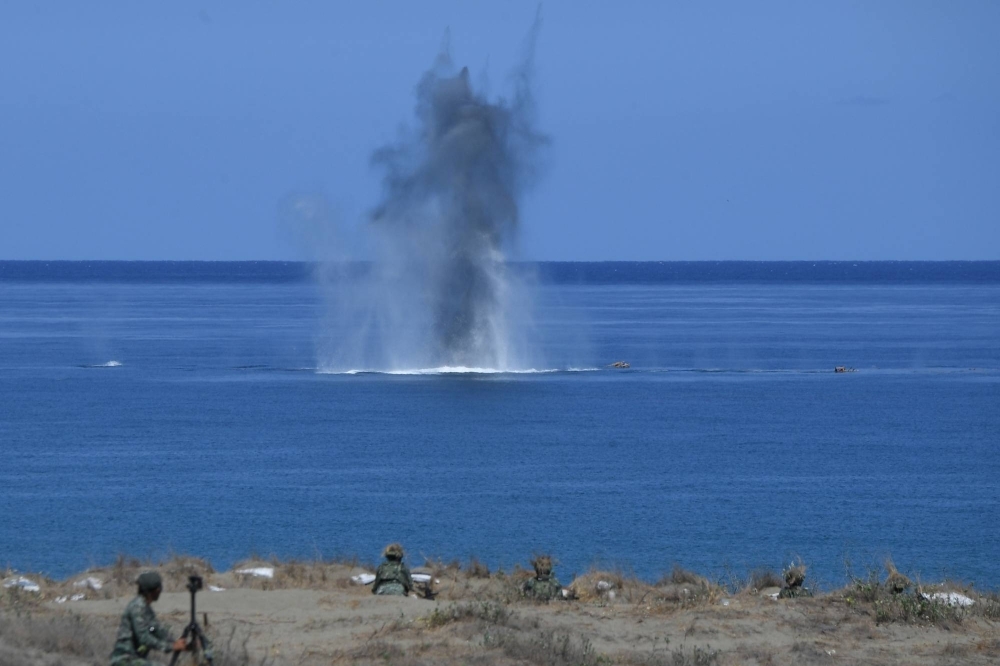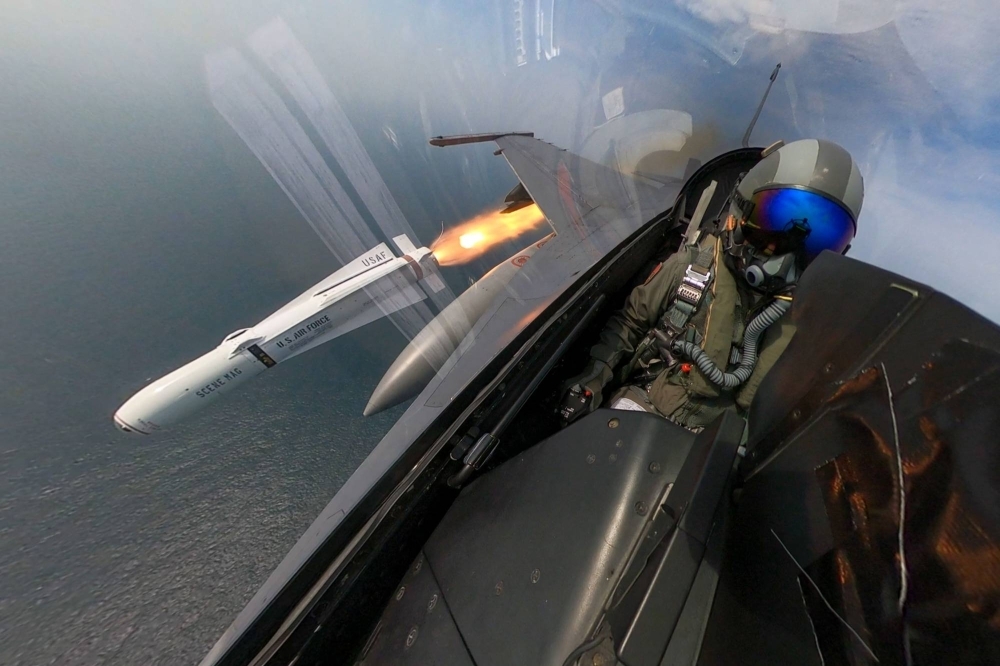U.S. builds web of arms, ships and bases in the Pacific to deter China

But the Biden administration says that is no longer good enough to foil what it sees as the greatest threat to the democratic island of Taiwan — a Chinese invasion that could succeed within days.
Since the start of his administration, President Joe Biden has undertaken a strategy to expand American military access to bases in allied nations across the Asia-Pacific region and to deploy a range of new weapons systems there. He has also said the U.S. military would defend Taiwan against a Chinese invasion.
On April 24, Biden signed a $95 billion supplemental military aid and spending bill that Congress had just passed and that includes $8.1 billion to counter China in the region. And Secretary of State Antony Blinken traveled to Shanghai and Beijing last month for meetings with President Xi Jinping and other officials in which he raised China’s military activity in the Taiwan Strait and the South China Sea, calling it “destabilizing.”
Xi told Blinken during his visit that the United States should not play a “zero-sum game” or “create small blocs.” He said that “while each side can have its friends and partners, it should not target, oppose or harm the other,” according to an official Chinese summary of the meeting.
Earlier in April, the leaders of the Philippines and Japan met with Biden at the White House for the first such summit among the three countries. They announced enhanced defense cooperation, including naval training and exercises, planned jointly and with other partners. Last year, the Biden administration forged a new three-way defense pact with Japan and South Korea. And Australia will soon be a new home to advanced American-made attack submarines.
“In 2023, we drove the most transformative year for U.S. force posture in the Indo-Pacific region in a generation,” Ely S. Ratner, the assistant secretary of defense for Indo-Pacific security affairs, said in a statement following an interview.
The main change, he said, is having American forces distributed in smaller, more mobile units across a wide arc of the region rather than being concentrated at large bases in Northeast Asia. That is largely intended to counter China’s efforts to build up forces that can target aircraft carriers or U.S. military outposts on Okinawa or Guam.
These land forces, including a retrained and refitted U.S. Marine littoral regiment in Okinawa, will now have the ability to attack warships at sea.

For the first time, Japan’s military will receive up to 400 of their own Tomahawk cruise missiles — the newest versions of which can attack ships at sea as well as targets on land from over 1,600 kilometers away.
The Pentagon has also gained access rights for its troops at four additional bases in the Philippines that could eventually host U.S. warplanes and advanced mobile missile launchers, if Washington and Manila agree that offensive weaponry can be placed there. Such an agreement would reduce the need for aircraft carriers that could be targeted by China’s long-range missiles and submarines in a time of war.
The United States has bilateral mutual defense agreements with several allied nations in the region so that an attack on the assets of one nation could trigger a response from the other. Bolstering the U.S. troop presence on the soil of allied countries strengthens that notion of mutual defense.
In addition, the United States continues to send weapons and Green Beret trainers to Taiwan, a de facto independent island and the biggest flash point between the United States and China. Xi has said his nation must eventually take control of Taiwan, by force if necessary.
“We’ve deepened our alliances and partnerships abroad in ways that would have been unthinkable just a few years ago,” Kurt Campbell, the new deputy secretary of state, told reporters last year when he was the top Asia policy official in the White House.
Xi and other officials in Beijing have watched the U.S. moves with alarm. They call it an encirclement of their nation and say the United States is trying to constrain its main economic and military rival.
Taiwan’s foreign minister, Joseph Wu, said in an interview in Taipei that the strengthened alliances and evolving military force postures were critical to deterring China.
“We are very happy to see that many countries in this region are coming to the realization that they also have to be prepared for further expansions of the PRC,” he said, referring to the People’s Republic of China.
To some Chinese military strategists, the U.S. efforts are aimed at keeping China’s naval forces behind the “first island chain” — islands close to mainland Asia that run from Okinawa in Japan to Taiwan to the Philippines.

U.S. military assets along these islands could prevent Chinese warships from getting into the open Pacific waters farther east if conflict were to break out.
Leaders in China’s People’s Liberation Army also talk of establishing military dominance of the “second island chain” — which is farther out in the Pacific and includes Guam, Palau and West Papua.
But several conservative critics of the administration’s policies argue that the United States should be keeping major arms for its own use and that it is not producing new ships and weapons systems quickly enough to deter China, which is rapidly growing its military.
Some American commanders acknowledge the United States needs to speed up ship production but say the Pentagon’s warfighting abilities in the region still outmatch China’s — and can improve quickly with the right political and budget commitments in Washington.
“We have actually grown our combat capability here in the Pacific over the last years,” Adm. Samuel J. Paparo Jr. said in an interview before becoming the head of the U.S. Indo-Pacific Command on May 3. “But our trajectory is still not a trajectory that matches our adversary. Our adversaries are building more capability and they’re building more warships — per year — than we are.”
Paparo said new American warships were still more capable than the ones China is building, and the U.S. military’s “total weight of fires” continued to outmatch that of the People’s Liberation Army, for now.
The Intermediate-Range Nuclear Forces Treaty, a Cold War-era arms control agreement between Washington and Moscow, prohibited land-based cruise or ballistic missiles with ranges between 500 to 5,500 km (310 to 3,420 miles). But after the Trump administration withdrew from the pact, the United States was able to develop and field a large number of small, mobile launchers for previously banned missiles around Asia.
Even with the deployment of new systems, the United States would still rely on its legacy assets in the region in the event of war: its bases in Guam, Japan and South Korea, and the troops and arms there.
All of the senior U.S. officials interviewed for this story say war with China is neither desirable nor inevitable — a view expressed publicly by Defense Secretary Lloyd Austin. But they also insist that a military buildup and bolstering alliances, along with diplomatic talks with China, are important elements of deterring potential future aggression by Beijing.

Wang Yi, China’s foreign minister, told Blinken last month in Beijing that “the negative factors in the relationship are still increasing and building, and the relationship is facing all kinds of disruptions.” He warned the United States “not to interfere in China’s internal affairs, not to hold China’s development back, and not to step on China’s red lines and on China’s sovereignty, security and development interests.”
The new deterrent effort is twofold for American forces: increasing patrolling activities at sea and the capabilities of its troop levels ashore.
To the former, the Pentagon has announced that U.S. Navy warships will participate in more drills with their Japanese counterparts in the western Ryukyu Islands near Taiwan and with Filipino ships in the South China Sea, where the Chinese coast guard has harassed ships and installations controlled by the Philippines.
To the latter, Marine Corps and Army units already in the Pacific have recently fielded medium- and long-range missiles mated to small, mobile trucks that would have been prohibited under the former treaty.
These trucks can be quickly lifted by Osprey tilt-rotor aircraft or larger cargo planes to new locations, or they can simply drive away to evade a Chinese counterattack. A new flotilla of U.S. Army watercraft being sent to the region could also be used to reposition troops and launchers from island to island.
In an interview last year with The New York Times, Gen. David H. Berger, then the Marine Corps’ top general, said the service had begun analyzing strategic choke points between islands where Chinese forces were likely to transit throughout the Pacific. He said the service had identified sites where Marine assault forces like the new Okinawa-based littoral regiment could launch attacks on China’s warships using these new weapons.
The Pentagon announced in February last year a new military base-sharing agreement with Manila, giving U.S. forces access to four sites in the Philippines for use in humanitarian missions, adding to the five sites previously opened to the Pentagon in 2014. Most of them are air bases with runways long enough to host heavy cargo planes.
Plotting their locations on a map shows the sites’ strategic value should the United States be called upon to defend its oldest treaty ally in the region, if the Philippines eventually agrees to allow the U.S. military to put combat troops and mobile missile systems there.

One, on the northern tip of Luzon Island, would give missile-launching trucks the ability to attack Chinese ships across the strait separating Philippines from Taiwan, while another site more than 1,100 km (about 700 miles) to the southwest would allow the U.S. to strike bases that China has built in the Spratly Islands nearby.
In 2023, the United States committed $100 million for “infrastructure investments” at the nine bases, with more funds expected this year.
The Pentagon has forged closer military ties with Australia and Papua New Guinea, extending America’s bulwark against potential attempts by the Chinese military at establishing dominance along the “second island chain.”
The Obama administration moved a number of littoral combat ships to Singapore and deployed a rotating force of Marines to Darwin, on Australia’s north coast, giving the Pentagon more assets that could respond as needed in the region.
Last year, the Biden administration greatly elevated its commitment to Australia, which is one of the United States’ most important non-NATO allies.
A new multibillion dollar agreement called AUKUS — for Australia, the United Kingdom and the United States — will permanently transfer some of the U.S. Navy’s newest Virginia-class attack subs to Australia. The location of the new bases for those subs has not been announced, but the first group of Australian sailors who will crew them graduated from nuclear power training in the U.S. in January.
These stealthy submarines, which can fire torpedoes and Tomahawk missiles, will potentially add to the number of threats China faces in case of a regional war.
Just north of Australia, an agreement in August gave U.S. forces more access to Papua New Guinea for humanitarian missions and committed American tax dollars to update military facilities there.
To Paparo, this growing network of partnerships and security agreements across thousands of miles of the Pacific is a direct result of what he calls China’s “revanchist, revisionist and expansionist agenda” in the region that has directly threatened its neighbors.
“I do believe that the U.S. and our allies and partners are playing a stronger hand and that we would prevail in any fight that arose in the Western Pacific,” the admiral said.
“It’s a hand that I would not trade with our would-be adversaries, and yet we’re also never satisfied with the strength of that hand and always looking to improve it.”
This article originally appeared in The New York Times © 2024 The New York Times Company
Leave a Reply